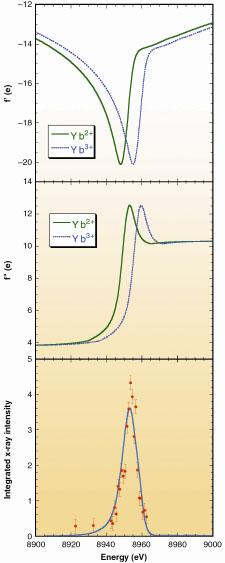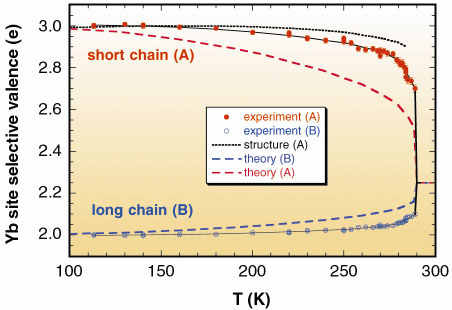- Home
- Users & Science
- Scientific Documentation
- ESRF Highlights
- ESRF Highlights 2001
- Magnetism and Electronic Properties of Solid
- Direct Observation of One-dimensional Charge Order in Yb4As3
Direct Observation of One-dimensional Charge Order in Yb4As3
Metal-insulator (MI) transitions have recently attracted renewed interest due, in particular, to their relevance for superconductivity and colossal magnetoresistance. The metal-insulator transition is often related to charge, orbital and/or magnetic order. Yb4As3 is an exotic material, with an incomplete metal-insulator transition, which has been proposed to be driven by a 1-dimensional charge order. At room temperature, Yb4As3 is a cubic metal. Assuming a charge of 3 for As, each Yb has an average non-integral valence of +2.25. At TMI ~ 290 K, there occurs a first-order structural phase transition from cubic to rhombohedral symmetry, associated with the metal-insulator transition. To quantitatively study the proposed 1-dimensional charge order, we have performed resonant X-ray diffraction at ID11 on a tiny crystal (40 x 40 x 40 µm3). A small crystal has the advantage that it is less likely to be destroyed when cooling through the transition.
The equally spaced Yb ions located along the body diagonal can be viewed as forming a chain labelled A, and the remaining Yb ions are labelled B. The experiments have focused on reflections for which the structure factor is proportional to (fA-fB). The difference in the scattering factor f of Yb2+ and Yb3+ far away from resonance is very small. However, in the vicinity of the Yb L3 resonances, which are split by 7 eV, the individual scattering factors are very different. Therefore, the diffracted intensity is strongly enhanced (Figure 97), giving direct evidence of the 1-dimensional charge order.
 |
Fig. 97: Energy dependence of the real (f'; top), and the imaginary (f''; center) parts of the scattering factors of Yb2+ and Yb3+, and of the 30 |
To reliably describe the energy dependence of these reflections, knowledge of the real and imaginary parts of the scattering factors is required. This we obtained from X-ray absorption data and the Kramers-Kronig transformation. The calculated energy-dependent intensity compares well with the experiment and is a direct indication of the 1-dimensional charge order in Yb4As3. The proportionality of the resonant diffracted intensity to (fA-fB)2 allows a quantitative determination of the temperature-dependent valences (Figure 98).
 |
Fig. 98: Temperature dependence of the site-selective Yb valence/hole concentration from resonant diffraction (open/closed circles), from the model [1] (broken curve) and from the structure (dotted curve). |
Our results have direct implications on the model, which describes the electronically driven metal-insulator transition in terms of a band Jahn-Teller effect of correlated electrons [1]. The Yb valence of site A decreases much less with increasing temperature than predicted by the model. The Yb valence can also be estimated from the length of the body-diagonal of the distorted cube. Surprisingly, the temperature dependence of the valence determined in this way is distinctly weaker than that of the hole concentration on the chain. This may be due to the strong Coulomb repulsion between ordered holes, to an electronic contribution to the lattice expansion or to different fluctuation time scales of the charge and the lattice distortions.
In conclusion, resonant X-ray scattering experiments on Yb4As3 directly confirm the existence of the 1-dimensional charge order of holes on the Yb sites below TMI. In addition, a temperature-dependent hole ordering is obtained which, surprisingly, does not follow the structural distortion.
Reference
[1] P. Fulde, B. Schmidt and P. Thalmeier, Europhys. Lett. 31, 323 (1995).
Principle Publication and Authors
U. Staub (a), B.D. Patterson (a), C. Schulze-Briese (a), F. Fauth (a,b), M. Shi (a), L. Soderholm (c), G.B.M. Vaughan (b) and A. Ochiai (d), Europhys. Lett. 53, 72 (2001).
(a) Swiss Light Source, Paul Scherrer Institute, Villigen (Switzerland)
(b) ESRF
(c) Chemistry Division, Argonne National Laboratory, Argonne, (USA)
(d) Center for Low Temperature Science, Tohoku University, Sendai, (Japan)



